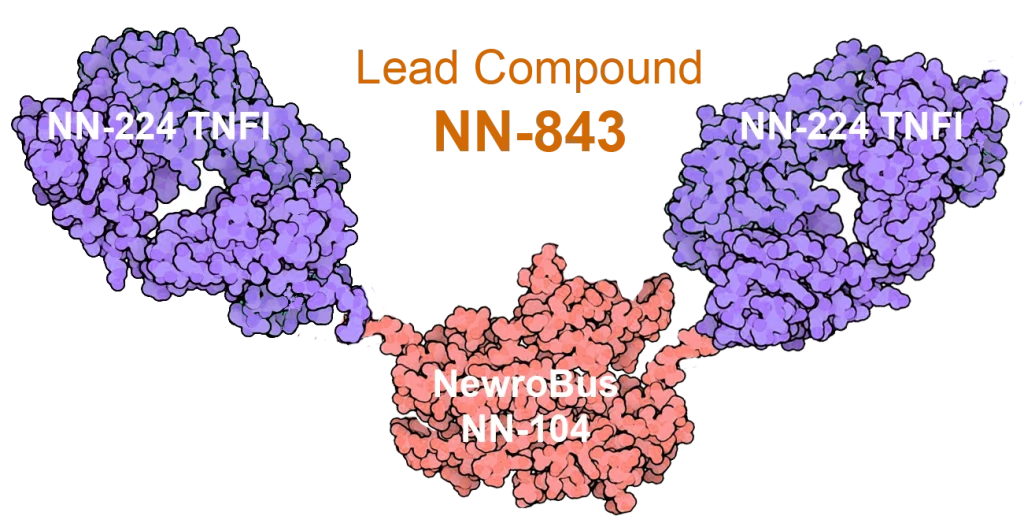About Us
We believe that many degenerative CNS diseases could be treated successfully with biologics. Unfortunately, biologics do not cross the Blood Brain Barrier (BBB). We have developed a series of humanized camelid nanobodies (NewroBus Technology) that can carry biologics across the BBB exploiting Transferrin Receptor 1 (TfR1) mediated transcytosis.
Our first clinical target is Alzheimer’s Disease (AD). There is a growing evidence in animal models and human data, that TNF-α plays a critical role in the pathogenesis of AD and other neurodegenerative diseases. We have developed potent TNF-α Inhibitors (TNFI) that, once linked to a NewroBus carrier, penetrate in the brain showing high TNF- α inhibition with excellent tolerability.
NN-843, our lead clinical candidate for the treatment of AD, is a hetero-trimer consisting of one molecule of NewroBus NN-104 linked to two molecules of our proprietary TNF-α Inhibitor NN-224.

About NanoNewron
- Spin-out from Rutgers University
- Patented and versatile technology platforms, exclusively licensed worldwide
- NewroBus Technology Platform: Proprietary TfR1-Nano Antibodies that can carry biologics across the BBB, leveraging TfR1-mediated transcytosis
- Proprietary TNF-α Inhibitors Platform: Powerful TNF-α inhibitors (TNFI) developed in-house to be used with NewroBus to treat CNS Diseases
- Lead Product NN-843: A hetero-trimer, shown to efficiently cross the BBB, consisting of two molecules of proprietary TNFI NN-224 linked to NewroBus NN-104
- Why TNF-α as First Target for NewroBus? TNF-α plays a pathogenic role in many degenerative CNS diseases, including Alzheimer’s Disease (AD), but TNFI do not cross the BBB
- Why Alzheimer Disease as First Indication? Significant unmet needs potentially addressable by NN-843 given its ability to achieve high TNF-α inhibition in the brain with good tolerability
TNF-α–mediated reduction in inhibitory neurotransmission precedes sporadic Alzheimer’s disease pathology in young Trem2R47H rats.
Siqiang Ren, Lionel Breuillaud, Wen Yao, Kelly A. Norris, Simone P. Zehntner, Luciano D’Adamio
Source: Journal of Biological Chemistry, 2020, Volume 296
Microglia TREM2R47H Alzheimer-linked variant enhances excitatory transmission and reduces LTP via increased TNF-α levels.
Siqiang Ren, Wen Yao, Marc D Tambini, Tao Yin, Kelly A Norris, Luciano D’Adamio
Source: eLife, 2020
Transfixed by transgenics: how pathology assumptions are slowing progress in Alzheimer’s disease and related dementia research.
Luciano D’Adamio
Source: EMBO Molecular Medicine, 2023
Our Team
Marco Taglietti, MD, Chief Executive Officer. Dr. Taglietti served as President and Chief Executive Officer of Scynexis (Nasdaq:SCYX) from 2015 to 2022, as President of Forest Research Institute and Chief Medical Officer at Forest Laboratories (Nasdaq:FRX) from 2007 until 2014, as Senior Vice President, Head of Global Research at Stiefel Laboratories, from 2004 to 2007 and served in several executive positions from 1992 to 2004 at the Schering-Plough Research Institute. Dr. Taglietti has brought more than 30 different products to market.
Luciano D’Adamio, MD, PhD, is a distinguished neuroscientist and professor at Rutgers, the State University of New Jersey, holding the Herbert C. and Jacqueline Krieger Klein Endowed Chair since 2017. His extensive career spans pivotal roles, including principal investigator at the NIH and professor at Albert Einstein College of Medicine. As a scientific co-founder of multiple biotech companies, including NanoNewron, Dr. D’Adamio has made transformative contributions to Alzheimer’s disease research, with honors such as the Alzheimer Medal and the Zenith Award from the Alzheimer’s Association. He serves on editorial boards of leading journals and has been recognized for his groundbreaking work in neurodegenerative diseases and translational neuroscience.
Bahar Aksoy Yesiltepe is a Lab Manager and Research Assistant at Rutgers University, specializing in laboratory operations, procurement, project management and safety compliance. With a background in theatre (B.F.A., Beykent University, Turkey) and knowledge management (A.A., Sakarya University, Turkey), she combines creativity with analytical skills to streamline organizational processes, optimize resource management, and enhance operational efficiency. She plays a key role in project management and coordination, team communication, vendor relations, and company documentation, ensuring smooth and effective operations.



